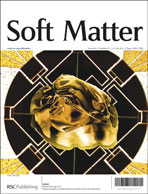A study of hydrogel composites containing pH-responsive doubly crosslinked microgels†
Abstract
Recently, our group established a new approach for preparing injectable hydrogels using vinyl-functionalised pH-responsive microgel particles [Liu et al., Soft Matter, 2011, 7, 4696]. pH-responsive microgels swell when the pH approaches the pKa of the particles. Liu et al. used inter-particle crosslinking of vinyl-functionalised microgel particles to prepare hydrogels composed of doubly crosslinked microgels (D-microgels). Here, we combine vinyl-functionalised microgels with added, small-molecule, crosslinkers to prepare high modulus D-microgel/hydrogel (H-X) composites for the first time. The vinyl-functionalised microgel particles used were poly(EA/MAA/BDD)/GM; where, EA MAA, BDD and GM are ethyl acrylate and methacrylic acid, 1,4-butanediol diacrylate and glycidyl methacrylate, respectively. Two added crosslinkers were used to demonstrate the versatility of our approach. They were ethyleneglycol dimethacrylate (EGD) and N,N′-methylenebisacrylamide (BA). We compare the data to control hydrogel composites prepared using non-vinyl-functionalised singly crosslinked microgels (S-microgels). All of the composites showed pH-dependent swelling behaviours and mechanical properties. The storage modulus value for the as-made D-microgel/H-EGD composite was 0.12 MPa and is the highest reported to date for a hydrogel containing pH-responsive microgels. The as-made control S-microgel/H-X composites had high ductilities. Dynamic rheology data were used to determine the effects of vinyl functionalisation on the composite mechanical properties. All of the composites exhibited pH-dependent swelling and a “breathing in” transition occurred. The swollen D-microgel/H-X composites retained their high modulus values upon swelling; although, their ductilities decreased. Because we used two different crosslinkers and pH-responsive microgels containing carboxylic acid groups, the method introduced here for preparing high modulus hydrogel composites should be widely applicable.


 Please wait while we load your content...
Please wait while we load your content...